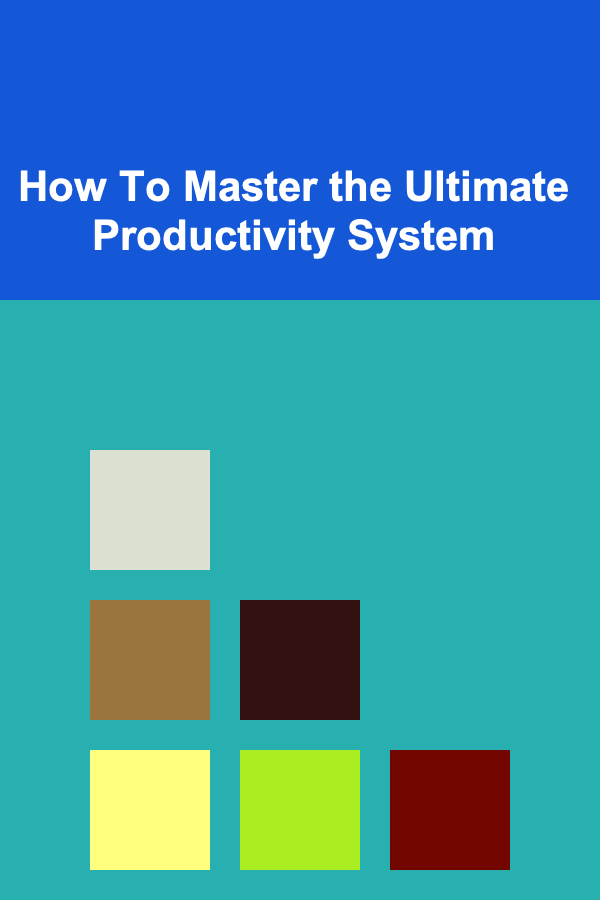
How To Master the Ultimate Productivity System
ebook include PDF & Audio bundle (Micro Guide)
$12.99$11.99
Limited Time Offer! Order within the next:

In the fast-paced world of today, productivity is not just a buzzword but a necessity. Whether you're working in a corporate job, running your own business, or pursuing personal projects, managing your time effectively is a challenge that everyone faces. The ultimate productivity system is not about finding a magic formula that works for everyone. Instead, it's about discovering a tailored approach that fits your unique needs, circumstances, and goals.
In this article, we will explore how to master the ultimate productivity system, which combines modern productivity techniques, mindset shifts, and practical strategies to help you stay focused, efficient, and motivated. By understanding the core principles of productivity, you'll be able to build a system that works for you, leading to a more balanced and fulfilling life.
Understanding Productivity
Before diving into systems and strategies, it's essential to understand what productivity really means. At its core, productivity is about achieving more in less time, but it's important to note that productivity is not solely about doing more tasks. It's about accomplishing tasks that are important, meaningful, and aligned with your goals. It's about maximizing your effectiveness and efficiency, not just the quantity of work you do.
Productivity can be divided into three major components:
- Time Management: Effectively organizing your time and balancing priorities to get the most out of your day.
- Task Management: Organizing and prioritizing tasks to ensure that you are working on the right things.
- Energy Management: Managing your physical and mental energy to avoid burnout and maintain sustainable productivity.
The ultimate productivity system will address all three components, ensuring that you're not just working harder but working smarter.
The Ultimate Productivity System: Key Principles
1. Clarify Your Vision and Goals
A productivity system without clear goals is like a ship sailing without a compass. The first step to mastering any productivity system is understanding your vision and setting clear, specific goals. Without knowing what you're working towards, it's easy to get lost in the daily grind and lose sight of what truly matters.
Setting SMART Goals
To ensure your goals are actionable and achievable, use the SMART framework:
- Specific: Define your goal with clarity. For example, "Increase sales" is vague, while "Increase sales by 20% in the next quarter" is specific.
- Measurable: Make sure you can track your progress. This helps you stay motivated and adjust your approach if needed.
- Achievable: Your goal should be realistic and within reach, given your resources and time.
- Relevant: Ensure your goals align with your overall life and career vision.
- Time-bound: Set a clear deadline for when you aim to accomplish your goal.
2. Prioritize Your Tasks
Once you have a clear vision and well-defined goals, the next step is prioritization. Not all tasks are created equal, and some will contribute more to your long-term success than others. Learning to prioritize effectively is key to maximizing productivity.
The Eisenhower Matrix
One of the most powerful prioritization tools is the Eisenhower Matrix, which divides tasks into four quadrants:
- Urgent and Important: Tasks that need immediate attention and contribute significantly to your goals. These should be your top priority.
- Not Urgent but Important: Tasks that contribute to long-term success but don't require immediate attention. These should be planned and worked on steadily over time.
- Urgent but Not Important: Tasks that require immediate attention but don't contribute much to your long-term success. These should be delegated or minimized.
- Not Urgent and Not Important: Tasks that don't add much value and don't require immediate attention. These should be eliminated or reduced.
By applying the Eisenhower Matrix, you can ensure that you're spending most of your time on tasks that have a meaningful impact on your goals.
3. Time Blocking
Time blocking is one of the most effective techniques for mastering productivity. It involves setting aside specific blocks of time for specific tasks or activities. By doing this, you ensure that you stay focused on the task at hand without distractions, and you also prevent tasks from dragging on unnecessarily.
How to Time Block:
- Identify Your Most Important Tasks: Look at your to-do list and identify which tasks are the most important and need dedicated focus.
- Create Time Blocks: Allocate specific blocks of time for each task. For example, 9:00 AM to 10:30 AM for writing a report, 11:00 AM to 12:00 PM for meetings, etc.
- Set Boundaries: Treat your time blocks as appointments that cannot be interrupted. This ensures you stay focused and avoid multitasking.
- Review and Adjust: Regularly assess how well your time blocks are working and make adjustments as needed to optimize your schedule.
4. The Pomodoro Technique
The Pomodoro Technique is a time management method developed by Francesco Cirillo. It involves working in short, focused intervals (typically 25 minutes), followed by a short break (5 minutes). After four intervals, you take a longer break (15-30 minutes). This technique helps maintain focus and prevents burnout by balancing work with rest.
Steps to Use the Pomodoro Technique:
- Choose a Task: Select a task you want to focus on.
- Set a Timer: Set a timer for 25 minutes (one Pomodoro).
- Work Without Distractions: Focus solely on the task at hand, avoiding any distractions.
- Take a Short Break: After the Pomodoro ends, take a 5-minute break.
- Repeat: Continue the cycle for four Pomodoros, then take a longer break.
By breaking your work into manageable intervals, the Pomodoro Technique helps maintain focus while preventing mental fatigue.
5. Automate and Delegate
The ultimate productivity system is about working smarter, not harder. One of the best ways to optimize productivity is by automating repetitive tasks and delegating tasks that don't require your specific expertise.
Automating Tasks
There are countless tools available that can help automate repetitive tasks, such as:
- Email filters and auto-responses: Automate email sorting and responses to save time.
- Project management tools : Use tools like Asana, Trello, or Monday.com to automate task assignments and deadlines.
- Social media management: Use platforms like Buffer or Hootsuite to schedule and manage social media posts.
Delegating Tasks
Delegating tasks that are outside your core expertise or that others can do more efficiently is another key strategy. This frees up your time to focus on high-priority tasks that directly contribute to your goals.
- Outsource administrative tasks: Hire a virtual assistant or delegate time-consuming tasks like data entry, scheduling, or customer support.
- Collaborate effectively: In a team environment, assign tasks based on each team member's strengths and expertise.
6. Focus on Energy Management
Managing your energy is just as important as managing your time. Productivity isn't just about how many tasks you can complete in a day; it's about ensuring that you have the energy to perform at your best. Working long hours without adequate rest can lead to burnout and decreased efficiency.
Strategies for Energy Management:
- Sleep: Get 7-9 hours of quality sleep each night to maintain focus and cognitive function throughout the day.
- Exercise: Regular physical activity boosts energy levels and improves mental clarity.
- Nutrition: Eat a balanced diet to fuel your body and brain. Avoid heavy meals that can lead to sluggishness and fatigue.
- Breaks: Taking regular breaks, even if brief, helps replenish your mental and physical energy, preventing burnout.
7. Review and Reflect
Productivity is a continuous process, not a one-time fix. Regularly reviewing your progress and reflecting on what's working and what isn't will help you fine-tune your system and make necessary adjustments.
- Daily Review: At the end of each day, take a few minutes to review what you accomplished and what you could improve.
- Weekly Reflection: Reflect on your progress towards your long-term goals. What worked well? What challenges did you face? How can you adjust your approach in the upcoming week?
- Monthly Assessment: Every month, evaluate your overall productivity system. Are there any new strategies you want to incorporate? Are there any old habits or tools that need to be abandoned?
8. Maintain Consistency and Adaptability
The key to mastering the ultimate productivity system is consistency. It's important to stick to your system and practice good habits regularly. However, you must also remain adaptable and open to change. Life circumstances, business environments, and personal goals will evolve over time, and your system should evolve with them.
Being flexible and willing to adjust your system ensures that it remains effective even as your needs change.
Conclusion
Mastering the ultimate productivity system is a lifelong journey of trial, error, and refinement. By combining time management, task prioritization, energy management, and goal clarity, you can build a personalized productivity system that suits your unique needs and goals. Through consistent practice, regular review, and a willingness to adapt, you'll be able to stay focused, motivated, and efficient, ultimately achieving more in less time.
Productivity isn't just about doing more; it's about doing what matters most, with purpose, passion, and efficiency. By following the principles outlined above, you can unlock your full potential and create a system that helps you live a more balanced and fulfilling life.

How to Create Pet-Friendly Décor without Sacrificing Style
Read More
How to Keep Your Music Room Clutter-Free
Read More
How to Maintain a Clean Home with a Busy Family
Read More
How to Prioritize Financial Goals When You Have Limited Resources
Read More
How to Use Nature to Inspire Your Time Capsule Design
Read More
How to Plan a Vocal Warm-Up Rehearsal
Read MoreOther Products

How to Create Pet-Friendly Décor without Sacrificing Style
Read More
How to Keep Your Music Room Clutter-Free
Read More
How to Maintain a Clean Home with a Busy Family
Read More
How to Prioritize Financial Goals When You Have Limited Resources
Read More
How to Use Nature to Inspire Your Time Capsule Design
Read More